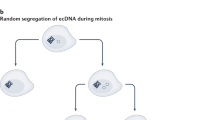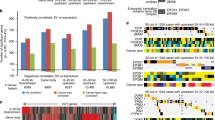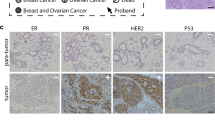Abstract
Basal cell carcinoma (BCC), the most common human cancer, results from aberrant activation of the Hedgehog signaling pathway1. Although most cases of BCC are sporadic, some forms are inherited, such as Bazex–Dupré–Christol syndrome (BDCS)—a cancer-prone genodermatosis with an X-linked, dominant inheritance pattern2. We have identified mutations in the ACTRT1 gene, which encodes actin-related protein T1 (ARP-T1), in two of the six families with BDCS that were examined in this study. High-throughput sequencing in the four remaining families identified germline mutations in noncoding sequences surrounding ACTRT1. These mutations were located in transcribed sequences encoding enhancer RNAs (eRNAs)3,4,5 and were shown to impair enhancer activity and ACTRT1 expression. ARP-T1 was found to directly bind to the GLI1 promoter, thus inhibiting GLI1 expression, and loss of ARP-T1 led to activation of the Hedgehog pathway in individuals with BDCS. Moreover, exogenous expression of ACTRT1 reduced the in vitro and in vivo proliferation rates of cell lines with aberrant activation of the Hedgehog signaling pathway. In summary, our study identifies a disease mechanism in BCC involving mutations in regulatory noncoding elements and uncovers the tumor-suppressor properties of ACTRT1.
This is a preview of subscription content, access via your institution
Access options
Access Nature and 54 other Nature Portfolio journals
Get Nature+, our best-value online-access subscription
$29.99 / 30 days
cancel any time
Subscribe to this journal
Receive 12 print issues and online access
$209.00 per year
only $17.42 per issue
Buy this article
- Purchase on Springer Link
- Instant access to full article PDF
Prices may be subject to local taxes which are calculated during checkout




Similar content being viewed by others
Accession codes
References
Epstein, E.H. Basal cell carcinomas: attack of the hedgehog. Nat. Rev. Cancer 8, 743–754 (2008).
Vabres, P. et al. The gene for Bazex–Dupré–Christol syndrome maps to chromosome Xq. J. Invest. Dermatol. 105, 87–91 (1995).
Natoli, G. & Andrau, J.C. Noncoding transcription at enhancers: general principles and functional models. Annu. Rev. Genet. 46, 1–19 (2012).
Lam, M.T., Li, W., Rosenfeld, M.G. & Glass, C.K. Enhancer RNAs and regulated transcriptional programs. Trends Biochem. Sci. 39, 170–182 (2014).
Mousavi, K., Zare, H., Koulnis, M. & Sartorelli, V. The emerging roles of eRNAs in transcriptional regulatory networks. RNA Biol. 11, 106–110 (2014).
Bazex, A., Dupré, A. & Christol, B. Follicular atrophoderma, baso-cellular proliferations and hypotrichosis. Ann. Dermatol. Syphiligr. (Paris) 93, 241–254 (1966).
Rapelanoro, R., Taïeb, A. & Lacombe, D. Congenital hypotrichosis and milia: report of a large family suggesting X-linked dominant inheritance. Am. J. Med. Genet. 52, 487–490 (1994).
Visel, A., Rubin, E.M. & Pennacchio, L.A. Genomic views of distant-acting enhancers. Nature 461, 199–205 (2009).
Nelson, A.C. & Wardle, F.C. Conserved non-coding elements and cis regulation: actions speak louder than words. Development 140, 1385–1395 (2013).
Nobrega, M.A., Ovcharenko, I., Afzal, V. & Rubin, E.M. Scanning human gene deserts for long-range enhancers. Science 302, 413 (2003).
Blow, M.J. et al. ChIP–Seq identification of weakly conserved heart enhancers. Nat. Genet. 42, 806–810 (2010).
Yang, S. et al. Functionally conserved enhancers with divergent sequences in distant vertebrates. BMC Genomics 16, 882 (2015).
Visel, A. et al. ChIP–seq accurately predicts tissue-specific activity of enhancers. Nature 457, 854–858 (2009).
Andersson, R. et al. An atlas of active enhancers across human cell types and tissues. Nature 507, 455–461 (2014).
Inoue, F. & Ahituv, N. Decoding enhancers using massively parallel reporter assays. Genomics 106, 159–164 (2015).
Wu, H. et al. Tissue-specific RNA expression marks distant-acting developmental enhancers. PLoS Genet. 10, e1004610 (2014).
Korkmaz, G. et al. Functional genetic screens for enhancer elements in the human genome using CRISPR–Cas9. Nat. Biotechnol. 34, 192–198 (2016).
Xie, J. et al. Activating Smoothened mutations in sporadic basal-cell carcinoma. Nature 391, 90–92 (1998).
Gailani, M.R. et al. The role of the human homologue of Drosophila patched in sporadic basal cell carcinomas. Nat. Genet. 14, 78–81 (1996).
Heid, H. et al. Novel actin-related proteins Arp-T1 and Arp-T2 as components of the cytoskeletal calyx of the mammalian sperm head. Exp. Cell Res. 279, 177–187 (2002).
Oma, Y. & Harata, M. Actin-related proteins localized in the nucleus: from discovery to novel roles in nuclear organization. Nucleus 2, 38–46 (2011).
Dion, V., Shimada, K. & Gasser, S.M. Actin-related proteins in the nucleus: life beyond chromatin remodelers. Curr. Opin. Cell Biol. 22, 383–391 (2010).
Medina, P.P. et al. Frequent BRG1/SMARCA4-inactivating mutations in human lung cancer cell lines. Hum. Mutat. 29, 617–622 (2008).
Zhan, X., Shi, X., Zhang, Z., Chen, Y. & Wu, J.I. Dual role of Brg chromatin remodeling factor in Sonic hedgehog signaling during neural development. Proc. Natl. Acad. Sci. USA 108, 12758–12763 (2011).
Jagani, Z. et al. Loss of the tumor suppressor Snf5 leads to aberrant activation of the Hedgehog–Gli pathway. Nat. Med. 16, 1429–1433 (2010).
Noubissi, F.K. et al. Role of CRD-BP in the growth of human basal cell carcinoma cells. J. Invest. Dermatol. 134, 1718–1724 (2014).
Krepischi, A.C. et al. Germline DNA copy number variation in familial and early-onset breast cancer. Breast Cancer Res. 14, R24 (2012).
Lo, W.W. et al. Involvement and targeted intervention of dysregulated Hedgehog signaling in osteosarcoma. Cancer 120, 537–547 (2014).
Yang, W. et al. Targeting hedgehog–GLI-2 pathway in osteosarcoma. J. Orthop. Res. 31, 502–509 (2013).
Kwon, Y.J. et al. Gli1 enhances migration and invasion via up-regulation of MMP-11 and promotes metastasis in ERα negative breast cancer cell lines. Clin. Exp. Metastasis 28, 437–449 (2011).
St Pierre, R. & Kadoch, C. Mammalian SWI/SNF complexes in cancer: emerging therapeutic opportunities. Curr. Opin. Genet. Dev. 42, 56–67 (2017).
Wilson, B.G. et al. Epigenetic antagonism between Polycomb and SWI/SNF complexes during oncogenic transformation. Cancer Cell 18, 316–328 (2010).
Kohashi, K. & Oda, Y. Oncogenic roles of SMARCB1/INI1 and its deficient tumors. Cancer Sci. 108, 547–552 (2017).
Ørom, U.A. et al. Long noncoding RNAs with enhancer-like function in human cells. Cell 143, 46–58 (2010).
Bartonicek, N., Maag, J.L. & Dinger, M.E. Long noncoding RNAs in cancer: mechanisms of action and technological advancements. Mol. Cancer 15, 43 (2016).
Tang, Y. et al. Linking long non-coding RNAs and SWI/SNF complexes to chromatin remodeling in cancer. Mol. Cancer 16, 42 (2017).
Yang, L. et al. lncRNA-dependent mechanisms of androgen-receptor-regulated gene activation programs. Nature 500, 598–602 (2013).
Zabidi, M.A. & Stark, A. Regulatory enhancer-core-promoter communication via transcription factors and cofactors. Trends Genet. 32, 801–814 (2016).
Wei, J.W., Huang, K., Yang, C. & Kang, C.S. Non-coding RNAs as regulators in epigenetics (Review). Oncol. Rep. 37, 3–9 (2017).
Acknowledgements
The authors wish to thank P. Guigue, A. Vincent-Salomon, L. Fuhrmann, M. Oufadem, S. Thomas, S. Petit, F. Mouchrik, V. Geoffroy, A. Julien, O. Duchamp de Lageneste, L. Galmiche-Rolland, J. Cottineau, J. Rossignol, S. Saunier and D. Pouly for technical assistance and advice; M. Sahbatou for performing linkage analysis; M.-E. Huang for providing cell lines for this study; A. Schmitt and J.-M. Masse at the Cochin Imaging Facility (CNRS UMR 8104) for their assistance and help with transmission electron microscopy; C. Bole-Feysot at the Genomic Platform of IMAGINE Institute for acquiring transcriptomic data; M. Garfa-Traoré, N. Goudin and R. Desvaux at the Cell Imaging Platform of IMAGINE Institute for technical assistance and advice; P. Guigue-Rodet and V. Martin-Bouret for providing skin biopsies from some individuals with BDCS; and M.-C. Hors-Cayla and J.-L. Bonafé for initiating genetic research on BDCS. We are grateful to all subjects and their families for their participation in the study. H.E. was supported by TUBITAK (grant no. 112S398). H.-S.P., E.C., F.K., D.B., M.H. and D.H. were supported by the Swiss National Science Foundation, the Placide Nicod Foundation and the Dind Cottier Foundation. This work was funded by the Association pour la Recherche contre le Cancer and the Société Française de Dermatologie. This work was supported by funding from the Agence Nationale de la Recherche (ANR-10-IAHU-01).
Author information
Authors and Affiliations
Contributions
E.B. designed and conducted most of the experiments and analyzed all the data. H.-S.P., E.C., F.K., D.B., M.H. and D.H. performed experiments on UW-BCC1 cells. Z.B.-C. contributed to the in vivo studies. H.K. collected BDCS families, provided clinical data, and performed and carried out analysis for linkage studies. M.N. and H.R.C. searched for CNEs and performed in silico analyses of the region around the ACTRT1 gene. M.M. assisted with all experiments. N.C. performed transcriptomic and Ingenuity analyses. C.L.G. contributed to sequencing of candidate genes. F.C. contributed to flow cytometry analyses and cell fractionation experiments. S.H. contributed to electron microscopy analyses. S.F. performed immunohistochemical analyses of skin biopsies. O.H. contributed to discussions on some aspects of the project. R.O.R. and A.D.A. extracted DNA from families E and F and performed linkage analyses. Q.W. helped with some in silico analysis on Turkish families. S.H-R., C.B., F.M.-P., B.L., F.C., J.M.-H., N.P., N.L., A.T. and M.-F.A. provided well-characterized patient samples. T.M. contributed to discussions and provided tools for experiments on the Hedgehog signaling pathway. G.G. performed targeted high-throughput sequencing. D.J.H. contributed to discussions on some aspects of the project. P.V. provided well-characterized patient samples and participated in drafting the manuscript. A.M. contributed to the study design and participated in drafting the manuscript. A.S. designed the study and wrote the manuscript.
Corresponding authors
Ethics declarations
Competing interests
The authors declare no competing financial interests.
Supplementary information
Supplementary Figures and Table
Supplementary Figures 1–19, Supplementary Table 1 and Supplementary Note (PDF 42033 kb)
Supplementary Data
Uncropped Immunoblots (PDF 3428 kb)
Rights and permissions
About this article
Cite this article
Bal, E., Park, HS., Belaid-Choucair, Z. et al. Mutations in ACTRT1 and its enhancer RNA elements lead to aberrant activation of Hedgehog signaling in inherited and sporadic basal cell carcinomas. Nat Med 23, 1226–1233 (2017). https://doi.org/10.1038/nm.4368
Received:
Accepted:
Published:
Issue Date:
DOI: https://doi.org/10.1038/nm.4368
This article is cited by
-
Establishment and evaluation of ectopic and orthotopic prostate cancer models using cell sheet technology
Journal of Translational Medicine (2022)
-
TBX5-AS1, an enhancer RNA, is a potential novel prognostic biomarker for lung adenocarcinoma
BMC Cancer (2021)
-
ARP-T1-associated Bazex–Dupré–Christol syndrome is an inherited basal cell cancer with ciliary defects characteristic of ciliopathies
Communications Biology (2021)
-
Gli promotes tumor progression through regulating epithelial-mesenchymal transition in non–small-cell lung cancer
Journal of Cardiothoracic Surgery (2020)
-
Hereditäre Hauttumorsyndrome
Der Hautarzt (2019)



